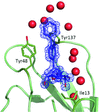issue contents
May 2016 issue

scientific commentaries
BIOLOGY | MEDICINE
Nass et al. [IUCrJ (2016), 3, 180–191] have demonstrated that serial femtosecond crystallography (SFX) data collected at X-ray free-electron lasers (XFELs) can be successfully phased using only the weak anomalous scattering from the native S atoms.
research letters
BIOLOGY | MEDICINE
A comparison of the different conformations adopted by C-glycosylated mannosides in FimH crystal structures is reported together with the investigation of new interactions.
research papers
NEUTRON | SYNCHROTRON
High-pressure single-crystal neutron Laue diffraction yields data suitable for fully anisotropic structure refinement, allowing joint X-ray and neutron studies of exactly the same sample. Remarkably, data completeness is similar to ambient-pressure measurements, despite the presence of a pressure cell.
PHYSICS | FELS
A systematic analysis of anomalous diffraction data obtained by serial femtosecond crystallography at an X-ray free-electron laser is presented and sulfur SAD phasing of SFX data from thaumatin microcrystals is demonstrated.
CHEMISTRY | CRYSTENG
Download citation


Download citation


A 3:1 stoichiometric co-crystal of benzene and ethane has been structurally characterized at 90 K using synchrotron powder X-ray diffraction following in situ crystal growth at 130 K. The conditions under which the co-crystal forms identify it as a potential evaporite material on the surface of Saturn's moon Titan.
CHEMISTRY | CRYSTENG
The application of X-ray diffraction topography in space materials science has promoted the acquisition of fundamental knowledge of space as a new technological environment. It has allowed a better understanding of the processes occurring during melt crystallization and the improvement of terrestrial methods of crystal growth for growing more homogeneous crystals.
CHEMISTRY | CRYSTENG
The change in the crystal structure of polymer-grafted nanoparticles during uniaxial stretching was investigated by simultaneous ultra-small-angle X-ray scattering and stress–strain measurement.
CHEMISTRY | CRYSTENG
Download citation


Download citation


Two dipolar biphenyls show significant 180° orientational disorder resulting in bipolar as-grown crystals. An added symmetrical biphenyl interferes with polarity formation and inverts the initial bipolar state.



 journal menu
journal menu




 access
access



















